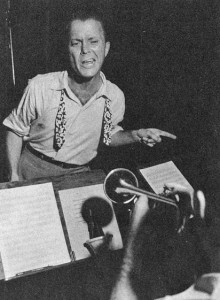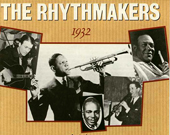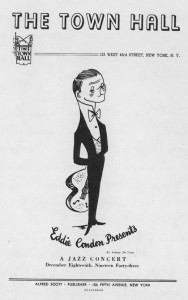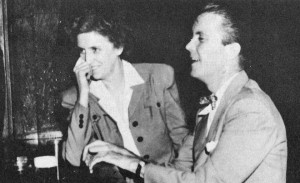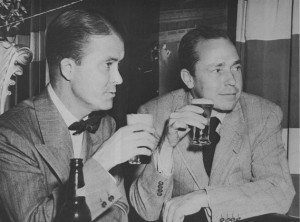A fast-talking, wisecracking Midwesterner, Eddie Condon epitomized Chicago Jazz and his Greenwich Village nightclub was the heart of the New York jazz scene in the 1940s.
Joining us on Riverwalk Jazz, photographer, author and record producer Hank O'Neal, who collaborated on Eddie Condon's Scrapbook of Jazz talks about the Condon legacy. And Eddie's daughter Maggie Condon shares her wealth of memories.
She paints this picture of her father at the height of his career:
"A couple facts about Eddie: he didn’t own a watch; he never did, never carried a wallet and had absolutely no ID on him wherever he went. When he went to Toots Shoors, or to any bar in NYC in the 40s and 50s they knew who he was. Inside his Cavanaugh (hat) his name was inscribed in the hat band— Eddie Condon. He’d order a couple of drinks, he’d take his hat off, he’d show it to the bartender and that was it, he was good to go. His hat was his ID. That’s what it was like for Eddie in New York in the heyday."
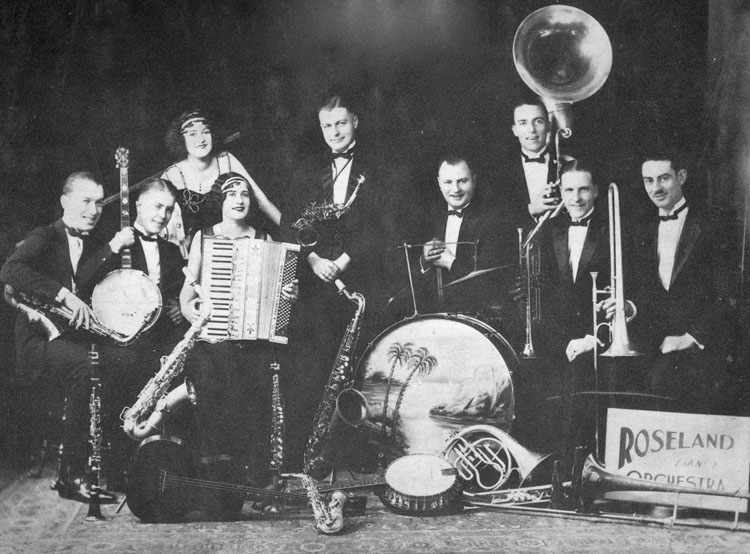
Eddie Condon with Hollis Peavey and Roseland Orchestra, 1923. Photo from Eddie Condon's Scrapbook of Jazz.
Eddie Condon was a renaissance man of jazz—a guitarist, bandleader, nightclub owner, author and first-rate wit. He won the Down Beat poll for “Best Jazz Guitar” in both 1943 and 44. When he passed away at age 67 in 1973, Condon left a rich legacy in his extensive catalogue of recorded music and in his jazz lore collected in his autobiography, We Called It Music.
Albert “Eddie” Condon was born in 1905 in Goodland, Indiana. Based in Chicago for much of the 1920s he played banjo with the Austin High Gang along with Jimmy McPartland, Gene Krupa and Frank Teschemacher. Condon switched to guitar and moved to New York in 1929, where he worked with Red Nichols' Five Pennies and Red McKenzie's Mound City Blue Blowers.
Throughout the 30s Condon organized and contracted musicians for New York recording sessions; many were racially mixed—a rarity at the time. Record collectors prize Condon's incomparable 1932 Rhythmakers sessions with Red Allen, Zutty Singleton, Pee Wee Russell, Fats Waller and Joe Sullivan, among others.
Hank O’Neal says:
"From the time Eddie Condon arrived in New York at the age of 22 on the eve of the Great Depression, he was a guy who could get things done. He always had tremendous energy. He talked fast and moved fast and jumped at every opportunity to put bands together and make records. And Eddie couldn’t care less whether a musician was black or white."
In the late 30s and early 40s Eddie Condon led recording sessions for Milt Gabler's Commodore label, had a nightly gig at Nick's in the Village and then produced a stellar series of live sessions at Town Hall for broadcast weekly on national radio. In the process Eddie Condon became a star of the Manhattan jazz scene.
Condon opened his first nightclub in 1945 on West Third in the Village. Simply called Condon’s, the club featured legendary soloists of the era—Bobby Hackett, ‘Wild Bill” Davison, Pee Wee Russell, Edmond Hall, Peanuts Hucko, Bob Wilber, Bud Freeman, Ralph Sutton and a host of others.
To this day, to describe a jazz band as playing “in the style of Eddie Condon” means that the band has a guitar and string bass in the rhythm section, and that it plays in a swinging 4/4 rhythm more closely related to a swing band than to a traditional New Orleans ensemble with banjo and tuba playing in 2/4. The “Condon Style” is synonymous with “Chicago Style,” and Condon’s nightclub was at the heart of that scene.
Hank O’Neal says about Condon’s nightclub:
"…it was a cauldron where wonderful people came together on a nightly basis. Not only the customers but the musicians came there. If you look at the photographs and the scrapbook that Eddie and I did all those years ago it was a Who’s Who of movie stars and writers and painters and musicians. And it wasn’t just jazz musicians, it was pop musicians, it was classical musicians. It was as famous as the Stork Club was uptown… Eddie wanted to make people feel good with his music and I think he succeeded admirably."
Eddie Condon lived in the same Greenwich Village flat for much of his adult life. Every afternoon he’d make the five-minute walk across Washington Square Park to his nightclub, a hot spot for the Manhattan “in crowd.” Kirk Douglas, John Steinbeck, Bing Crosby and Johnny Mercer were among the regulars.
When Condon wasn’t busy setting up concert and recording dates, or making the rounds at his club, he was raising his two daughters with the love of his life, his wife Phyllis. Phyllis spent her days writing copy for a New York advertising agency and in this week's show, Maggie Condon shares her mother's musing on life Condon-style and her own reflections growing up in their unusual household.
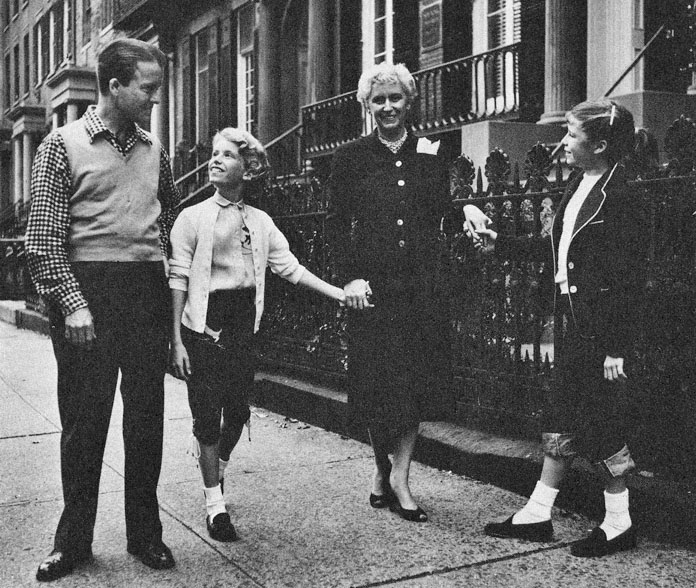
With Phyllis and daughters Maggie and Liza on Washington Square, NYC. Photo from Eddie Condon's Scrapbook of Jazz.
Here Maggie describes visits to her father's nightclub when she was a kid:
"We usually went to the club when they were preparing to open, early in the afternoon after school. Making Shirley Temples with all the cherries was a big deal. Liza and I would just take over the long bar while the guys were cleaning up getting ready for the night. Then we'd go down to the basement. That's where all the action was cuz that's where the house cat lived and there was often a litter of kittens. The other thing we used to love was the electric train set. Wild Bill Davison was an electric train lover and collector so they had an electric train in the room where the guys used to take their breaks."
And when Maggie was asked by host David Holt how her famous father would like to be remembered, she replied:
"I think Eddie’s small band was like a democracy. Every player was equal. Every player had a unique voice that they expressed when they took their solos—except Dad—who never took a solo. He was the spark plug. I think that’s how he thought of himself. It was a different band when he was there and when he wasn’t. Everyone was equal in the band. There was no ‘leader.’ He thought of himself as one of the guys. I think that’s how he’d like to be remembered. And the music. He lived for the music. That was probably number one."
Photo credit for Home Page: Eddie Condon and Johnny Mercer. Photo by Hank O'Neal.
Text based on Riverwalk Jazz script by Margaret Moos Pick ©2012


